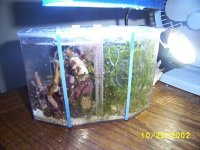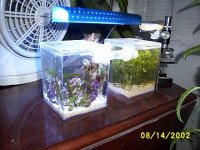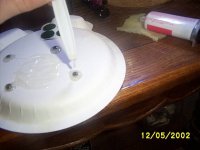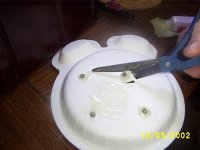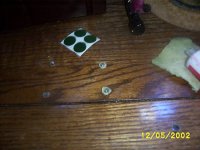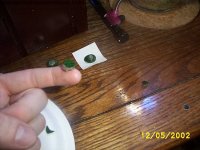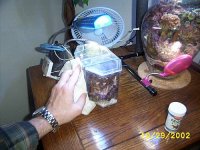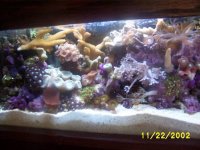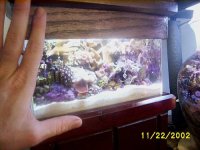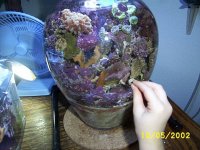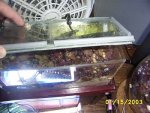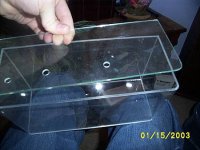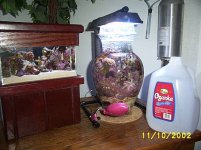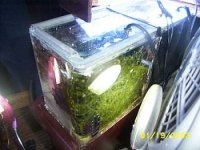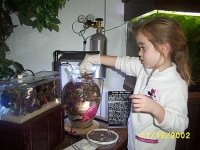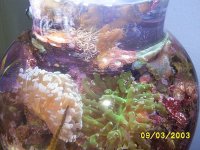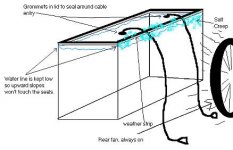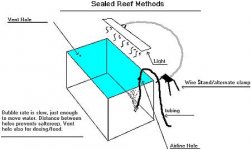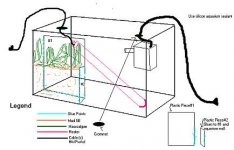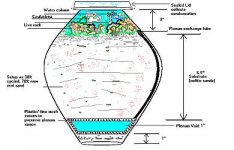That's a neat thread to post GD. Neat to see how the vote progressed over the last few months. I would amend my vote now, seeing as how we never refer to these small setups as atto reefs there'd be no reason to change it in favor of that. 2.5 on down are picos, anything on up to reasonable tank sizes are nanos.
The simplest way to understand pico reef design is to balance the waste production and the waste tolerance levels of any given setup. I figure anyone attempting pico reef setups have already kept larger ones and are familiar with temperature, current and salinity balancing requirements.
Those elements to do not change even down to the tiniest scale; the trick in the eye candy is to know that common LFS corals do not really count towards bioload, at least at the normal stocking density (# of polyps per square inch of LR surface area). Waste tolerance in a linear scale could best be defined as one end being imbalances in nitrite and ammonia, quickly lethal, to imbalances in nitrate and various compounds, slowly lethal. This end comprises the 'old tank syndrome' imbalances such as poor coral growth and heavy algal infestation.
Water changes are the key element in keeping your reef clean. Hardier corals can adapt to 75% changes or more on a weekly or bi-weekly basis, depending on waste productions in your design and the match of the change-water. Water change practice is among the basic skills any pico reef aquarist should have before attempting very small designs.
With that being said, consider taking a glass vase and filling it with two inches of live sand, several large chunks of LR to take up
most of the space (this is the filtration component) and filling this up with saltwater and an airstone placed under the back of the wall, out of view. Find a lid from a garden store used to house vased lilies, thin plastic lid (very cheap) used to keep the lilies suspended in the neck of betta-bowl setups. Invert this and use it like a cover for the reefbowl. This helps condensation fall back into the tank, sitting on the inner diameter of the neck there is very little drip off the sides of the tank.
At this point, you have water balance, LR, Sand and temp control provided you have decent airconditioning or a fan. You'll see that the salinity raises from .024 to .026-7 within three days, at this point one should use distilled water to topoff a few ounces back to .024. So there that part is, salinity control in the gallon reef aquarium.
So the system is humming along, cycling towards the pico balance and you add a coral frag of some kind from the LFS. You start changing the water 20% bi-weekly to prepare for the reef regimen. Nothing changes, the frag does its thing and your system does the same. Add a few more, still no changes. Get some hermits or shrimps and watch them add diversity to the system, some macro etc. After some time in this state, you see small algae patches develop on the LR which tells you its time to scrub them with a firm toothbrush and increase water changes to 75% bi-weekly, the system is now balanced and can run indefinately at this point if the bioload does not increase.
This is the time to purchase liquid calcium and alkalinity dosing agents and begin use. Dosing frequency and intensity is a key design change to make if a practiced aquarist plans to keep stony corals in such a setup. Soft coral setups need the dosing too--helps to maintain pH stability and calcification in the tiny system that tends to accumulate bio-acids from waste degredation. Water changes can be used to replenish these elements and this is a common practice. Considering the acid production of the stocked and cycled system I feel it is much eaiser to dose on alternate days of the week and put off water changes for the weekly or bi-weekly maintenence. Changing the water any more often to keep the same ionic levels as the dosing (if that could even be achieved) is a lot more work than I want in a pico.
Any reefbowl setup that is not too densely stocked would be the cheapest, easiest, most stable pico reef anyone could have. The fragile nature of the decorative glass is the only setback. I recommend using green star polyps, mushrooms and small leather coral fragments as these are a staple of the aquarium homegrown trade and are of no impact to the environment. Cut them out as the grow, more grow back. I feel these design goals make widespread popularity of pico reefs socially palatable-- so I have no problem discussing the practice in public forums where potential first-time reef aquarists are reading up on the trade.
I can't remember any posts that specifically talked about the filtration, so I wrote you one here

Hope this helps, brandon429




